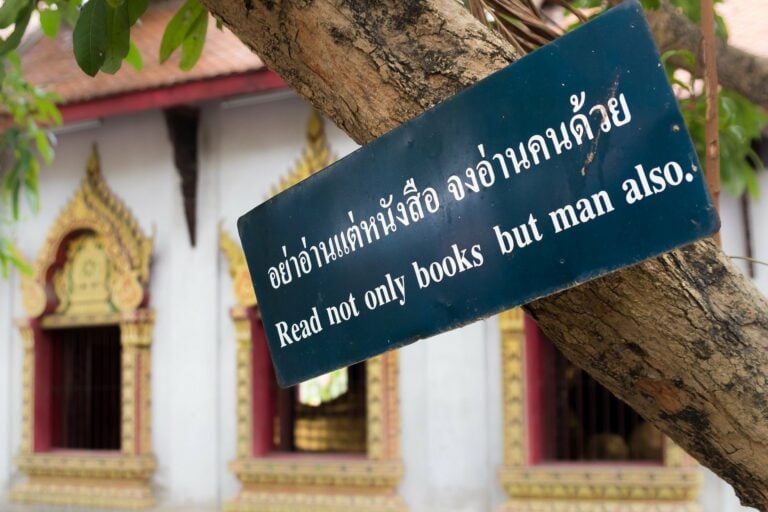It is possible to live in Thailand and get by without knowing the Thai language, but I don’t recommend it. In larger cities such as Bangkok and Chiang Mai, and places frequented by tourists such as Koh Samui or Phuket, the Thai staff in restaurants, shopping areas, and hotels should be able to understand enough English for you to not run into any big trouble. That said, if you’re living in Thailand (or even making an extended visit) your experience will be much enhanced by learning to speak some Thai.
Iglu offers complementary Thai language lessons at the Mae Hia office in Chiang Mai to help our employees get up to speed. The group lessons are with Kru Jan, who is also available for private tutoring in person or via Skype (Check her link in the Thai learning resources at the end of this post).
Why should you learn to speak Thai?
Just about any travel book will tell you that at least making an effort to learn some of the local language will be worthwhile no mater which country you’re visiting. Here are some of the best reasons I can think of for learning some Thai:
- Make friends
It should go without saying that learning Thai language will make it easier to make Thai friends. Wherever you go, you’ll find cab drivers, bar tenders, noodle sellers, and other Thai speakers who find a foreigner who speaks Thai to be somewhat of a novelty. They may not all turn into life-long friends, but maybe you notice the noodle seller start to give you extra big portions. Being able to joke around in Thai can also help break the ice when meeting new people. - Get around easier
Most Thai place names are horribly mispronounced by foreigners. When telling a taxi driver where you want to go, knowing how a Thai speaker would say the name of the place makes it much easier. - Get the local price
When shopping at an open-air market in Thailand, some bargaining is usually expected. If you look and sound like a tourist you’ll have a hard time getting the best prices. The seller will assume you don’t know any better so they’ll start bargaining from an over-inflated initial price. When you speak Thai, they’ll usually assume you have a better idea what the product is worth in local currency and you won’t have to put in as much effort to talk them down to an agreeable price.Being able to read Thai can also come in handy at many restaurants that have two different versions of their menu. Often, the Thai language version of the menu will have a much larger selection of dishes, and sometimes the prices will even be listed cheaper in the Thai menu compared to the English one. - Understand gossip
Thai people are known for their friendliness, but they’re not so different form people everywhere else in the world in that they love to gossip. If you act like you don’t understand a word of Thai, you’ll find yourself in situations where Thai people around you are talking about you under the assumption that you’re clueless to their gossip. It can be interesting to see the difference between what people want you to think and how they really feel. - Order food easier
If you aren’t picky about food you can always get by with pointing to something on the menu. But knowing a little bit of Thai can help you customize your order to get exactly what you want. You can say things like “extra rice”, “no onions”, “just a little sweet”, “very spicy” or “no ice”. - Becoming part of a community
If you’re from the US you know that immigrants who don’t speak English are cast in a bad light. The same would be true for immigrants in Germany not speaking German. So why would you expect Thailand to be any different? You’re never going to magically become a Thai person, but you should still try to integrate into your local community as much as you can. Many foreigners eventually end up marrying a Thai citizen and have Thai in-laws. Your relationship with your extended family will go much smoother when you can speak their language.
Learning Thai language basics
I’m only going to cover some of the bare minimum basic Thai phrases here because it is such an extensive topic. At the end of this article you’ll find links to some good resources for furthering your study of the Thai language.
Before I get any farther, I want to mention that the Thai language can’t really be accurately written out using the regular Roman alphabet. It is a tonal language, with each syllable having one of 5 different pitches: middle, low, high, rising, or falling. Everything else being the same, a different tone can completely change the meaning of a word. Furthermore, there are some consonant and vowel sounds found in the Thai language that English doesn’t have. So any transcription of Thai words here is just going to be an approximation of their sound value. Anyone serious about learning how to speak Thai should learn to read it. Learning both speaking and reading Thai concurrently will not only give you a well rounded understanding of the language, but also a greater understanding and appreciation of Thai culture too.
“Hello”- Sawat-dii khrap (male speaker) / Sawat-dii kha (female speaker)
“Thank you” – Khawp-khun khrap (male speaker) / Khawp-khun kha (female speaker)
“How are you?” – Sabai-dii mai
“I’m fine” – Sabai-dii
“What’s your name?” – Khun chue arai
“My name is ___” – Phom chue ___ (male speaker) / Di-chan chue ___ (female speaker)
“Nice to meet you” – Yin-dii thii dai ru-jak
“1” – Nueng
“2” – Sawng
“3” – Saam
“4” – Sii
“5” – Haa
“6” – Hok
“7” – Jet
“8” – Bpaet
“9” – Gao
“10” – Sip
Resources for learning Thai
- Learn Thai with Mod – One of the most popular online Thai teachers with entertaining video lessons.
- Speak Thai with Noi Naa – A Chiang Mai based Thai teacher with video lessons who is available for Skype tutoring.
- Study Thai with Kru Jan – Another Thai tutor in Chiang Mai. Iglu currently brings Jan into the Mae Hia office once a week for complementary employee Thai classes.
- AppeThai – Built by Iglu, the AppeThai app for iOS, Android, and Windows is a great resource for learning about Thai food.
- Reading Thai – Reading Thai is the most complete app for learning how to read the Thai script. It starts from the alphabet and takes you up to reading full sentences in Thai.
- ThaiPod101 – ThaiPod101 has tons of useful Thai video lessons on their YouTube channel. More in-depth study materials and audio lessons are available through subscription at their website.
- Learn Thai From A White Guy – Brett has developed a system from the last 10 years of teaching students that he now offers through his online courses.
- Duke Language School – Located on in a trendy facility only a 1 minute walk from Iglu’s Bangkok office. The school comes highly recommended by our Iglu crew for anyone based in Bangkok.
- There are also a good range of other Thai Language apps in the Apple App and Google Play Stores
This should give you a good start on your way to learning Thai. It might seem difficult at times, but don’t give up. Learning Thai is a fun and rewarding journey.





